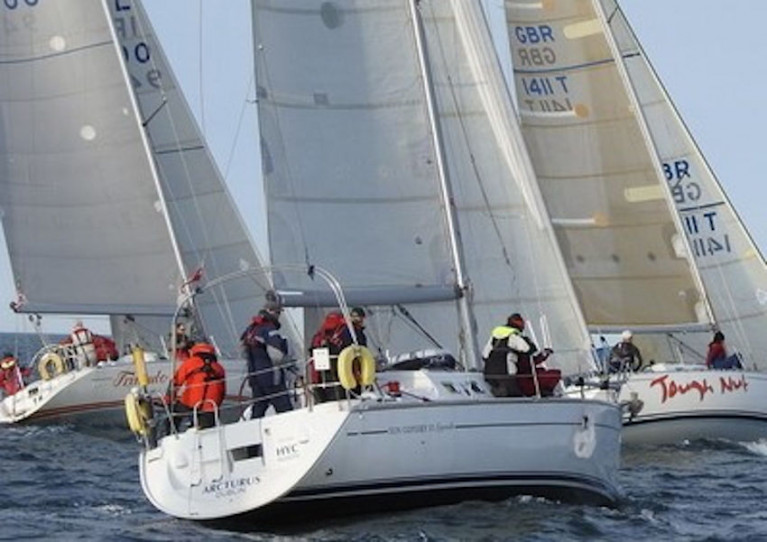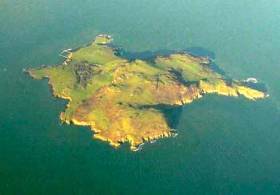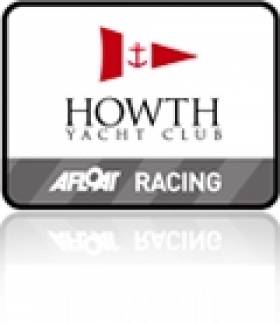Displaying items by tag: Lambay Races
Howth Yacht Club’s Lambay Races were sailed on Saturday (June 3rd) as a fully-fledged Open Event for the first time since 2019. Everything about it was on the grand scale – entry, sunshine, competition, tide, and après-sail were all maxed on the dial, whilst the northeast wind blew at a modest 6 to 8 knots to ensure that sailors - apart from frazzled tacticians - had plenty of energy left for socialising afterwards.
Eighty-six boats started, including visitors from Dun Laoghaire, Clontarf, and Malahide, who had a particular interest in checking out the Lambay to Ireland’s Eye course area that will host the 2023 ICRA National Championships this coming September.
The fleets started from two lines, with Race Officers David Lovegrove and Derek Bothwell overseeing proceedings to ensure a minimum of delay before the various classes got their racing underway.
 Although the wind was officially recorded as 8-10 knots nor’easter, a comprehensive modern selection of sails can work wonders with lighter pressures. Photo: Annraoi Blaney
Although the wind was officially recorded as 8-10 knots nor’easter, a comprehensive modern selection of sails can work wonders with lighter pressures. Photo: Annraoi Blaney
LIGHTISH GRADIENT WIND SUBSTITUTES FOR SEA BREEZE
A spring tide with high water twenty minutes before the first starts and a starboard rounding of Lambay promised a challenging leg north against the ebb. The light north-easterly ensured a sea-breeze never established, and it was steady in direction for the duration of the race, apart from the local effects in the lee of Lambay. After short first legs to windward marks for the two fleets, the leg to the island was initially a fetch but turned into a starboard tack-dominated beat. When the Perch at Lambay’s southwest corner reef was reached, the boats faced the challenge of “sailing uphill” as they navigated the channel between the Island and the shores of nearby Ireland.
 Getting the show on the road – Samatom starts to emerge ahead of the First 50 Checkmate XX (Dave Culllen & Nigel Biggs) Photo: Annraoi Blaney
Getting the show on the road – Samatom starts to emerge ahead of the First 50 Checkmate XX (Dave Culllen & Nigel Biggs) Photo: Annraoi Blaney
 X-Rated Area – Paddy Kynes’s Maximus battling to keep the wind clear on the Gore-Grimes clan’s Dux. Photo: Annraoi Blaney
X-Rated Area – Paddy Kynes’s Maximus battling to keep the wind clear on the Gore-Grimes clan’s Dux. Photo: Annraoi Blaney
ROCK-HOPPING REWARDED
Those who chose the middle of the channel in the hope of avoiding the island’s wind shadow soon found that they had backed the wrong horse, while those opting for the rock-hopping test of local knowledge/bravery along the Lambay western shoreline escaped the adverse tide, held their breeze, and reaped their reward. In many of the classes, the Perch marked the restart of the race, with the strong ebb down the channel quickly putting manners on those who thought they had a comfortable lead, but lost it by venturing too far from the Lambay shore.
 Who dares wins. In tacking against the tide in Lambay Sound, those who best drew the fine line between going close inshore without biffing a brick did best, and Robert Marshall is seen her taking the Squib Kerfuffle into the Lambay Lady win. Photo: Judith Malcolm
Who dares wins. In tacking against the tide in Lambay Sound, those who best drew the fine line between going close inshore without biffing a brick did best, and Robert Marshall is seen her taking the Squib Kerfuffle into the Lambay Lady win. Photo: Judith Malcolm
LAMBAY’S ROCK STRATA UNIQUELY MAGNETISES LEAD KEELS
Once the Taylor Rock Cardinal at the north-west corner was rounded, the beat across the north side offered the multitude of roosting sea birds the spectacle of the fleet making a close inspection of their cliff-side homes. Those cliffs are unusual in that they’re composed of a rare rock which has a magnetic attraction for lead keels, thus some skippers were wishing their depth-sounders scanned forward, rather than just confirming that a clunk and sudden stop means tacking 15 seconds earlier would have been prudent.
 Despite the depredations of avian flu, Kieran Jameson’s Sigma 38 Changeling found seabirds a-plenty on Lambay’s steep north coast Photo: Annraoi Blaney
Despite the depredations of avian flu, Kieran Jameson’s Sigma 38 Changeling found seabirds a-plenty on Lambay’s steep north coast Photo: Annraoi Blaney
 The 16-strong class of venerable Howth 17s were still close-packed as they tacked round Lambay with (left to right) Isobel (Turvey borthers, 1988), Aura (Ian Malcolm 1898) and Leila (Roddy Cooper 1898). Photo: Annraoi Blaney
The 16-strong class of venerable Howth 17s were still close-packed as they tacked round Lambay with (left to right) Isobel (Turvey borthers, 1988), Aura (Ian Malcolm 1898) and Leila (Roddy Cooper 1898). Photo: Annraoi Blaney
After the challenge of the north shore, the leg back south towards Ireland’s Eye provided idyllic sailing conditions, with all apart from the White Sail classes being wafted along under spinnakers in the sunshine. Even though the upwind and uptide work slowed progress for the first two-thirds of the race, most of the classes enjoyed at least three hours of racing, and some more than four.
 Running for home – the Lambay Race as visualised by Howth sailing ex-Pats worldwide. Photo: Annraoi Blaney
Running for home – the Lambay Race as visualised by Howth sailing ex-Pats worldwide. Photo: Annraoi Blaney
SENSIBLE COURSE SHORTENING
With a 17.00 time limit and the tide about to turn on some parts of the race area, the Race Committee took the prudent decision to shorten all the classes north of Ireland’s Eye and allow the sailors an early return ashore to the hospitality of Howth YC, a measure well-appreciated by those in need of rehydration.
 Class winner J/109 Indian (Simon Knowles) has a busy time of it aloft and alow in cutting the corner at Lambay’s East Point. Photo: Annraoi Blaney
Class winner J/109 Indian (Simon Knowles) has a busy time of it aloft and alow in cutting the corner at Lambay’s East Point. Photo: Annraoi Blaney
Lambay Race Class Results
Class 1 had an entry of 11 boats with Checkmate XX (Biggs/Cullen), a First 50, being the biggest boat afloat while Samatom (Robert Rendell) enjoyed the privilege of the Grand Soleil 44 being scratch boat in the fleet. The two of them put on a great exhibition of close-quarters competition around the course before Samatom finally took line honours by just 19 seconds after nearly three hours of racing. On corrected time, victory went to the currently-on-a-roll J/109 Indian (Simon Knowles), with Ghost Raider (Norbert Reilly) and Lambay Rules (Stephen Quinn) tying for second, only four seconds spanning the first three boats. Ghost Raider also took first on the HPH results.
13 boats competed for the honours in Class 2, and Pat O’Neill’s J/80 Mojo enjoyed the mix of conditions to take first on both IRC and HPH. Three X302s battled it out for the other IRC podium positions before Dux (C & N Gore-Grimes) and No Excuse (Wormald, Walsh and O’Neill) took second and third, leaving Maximus (Paddy Kyne) in fourth.
 Classic Frers – David Delamer’s handsome ketch Tritsch-Tratsch IV took a second in the White Sails. Photo: Annraoi Blaney
Classic Frers – David Delamer’s handsome ketch Tritsch-Tratsch IV took a second in the White Sails. Photo: Annraoi Blaney
Class 3, with six boats, saw close racing between Insider, Stephen Mullaney’s champion Sigma 33, and Gecko, the rejuvenated and ‘breathed upon’ Bolero 26 of Kevin Darmody. Insider took the IRC win by 36 seconds from Gecko while the Bolero took the HPH victory by a margin of over two minutes.
The White Sails boats were divided into Class 4 and Class 5 with nine and eight competitors respectively. On IRC the victories went to Bite the Bullet (Colm Bermingham) and Toughnut (Dermot Skehan) whilst Equinox (John McDonald) and Bandersnatch (Kyron O’Grady) topped the HPH lists. Class 4 saw the return to competition of the beautiful Tritsch Tratsch IV (David Delamer), which took second place on HPH.
The One Designs saw the Howth 17s, Puppeteer 22s, Squibs, E Boats and Ruffian 23s commit to a much longer race than they usually sail. The Howth 17s continued their 125th Anniversary celebrations and a 16-boat entry gave them bragging rights as the largest class afloat. Erica (Davie Nixon) showed the fleet a clean pair of heels and enjoyed a winning margin of 3.54 minutes over Hera (J and M Duffy), with current class champion, Rosemary (Curley, Jones and Potter), taking third place. Zaida (Houlihan, Hurley and Carrol) won on handicap.
 The Howth 17 Erica leads in ahead of her 16-strong class by 3.54 minutes - but it still wasn’t enough to win the Lambay Lady, which went to Killyleagh YC’s Robert Marshall with a 6 minute win in the Squibs. Photo: Judith Malcolm
The Howth 17 Erica leads in ahead of her 16-strong class by 3.54 minutes - but it still wasn’t enough to win the Lambay Lady, which went to Killyleagh YC’s Robert Marshall with a 6 minute win in the Squibs. Photo: Judith Malcolm
In the 10-strong Puppeteer fleet, Trick or Treat (Blay and Pearson) held the lead from the first mark to the finish. Despite some intense racing up the west side and around the back of Lambay with runner-up Yellow Peril (Costello and Murphy) and third placed HoneyBadger (Garrett May), Trick or Treat led around all the marks and went on to win by three minutes. Odyssey (P & R Byrne) were awarded the HPH trophy.
The E Boats and Ruffian 23s shared a start, and the respective race wins were taken by Smile E Too (Arnold Neeskens) from Clontarf Y&BC and Ruffrider (Finnie, Lee, Bell and Irvine) from Dun Laoghaire Motor YC.
 Keeping it in the family. Davy Nixon (right) won the Howth 17s with Erica, while his brother-in-law and current class National Champion Davy Jones (left) was third in Rosemary. Photo: Patricia Nixon
Keeping it in the family. Davy Nixon (right) won the Howth 17s with Erica, while his brother-in-law and current class National Champion Davy Jones (left) was third in Rosemary. Photo: Patricia Nixon
The Squibs continue their revival at Howth YC and the 8-boat entry included Killyleagh YC visitor Robert Marshall, who borrowed Kerfuffle from local class stalwart Emmet Dalton for the event. Robert, perhaps with the benefit of his Strangford experience, provided a masterclass of how to sail a Squib well in light wind and a strong tide, and built a winning margin of nearly six minutes over the course of the afternoon, leading home class newcomer Tom McMahon’s Tears in Heaven and Cool Beans (Thomas O’Reilly). Tom McMahon also took first place on handicap, a great result after just four weeks' experience in the class.
The Lambay Lady is the trophy awarded for the best performance of the regatta, and there was no surprise when Robert Marshall was announced as the very deserving and popular winner.
Full results can be found below, and Annraoi Blaney’s photographs of the racing and prizegiving ashore are available to view on the Howth YC website gallery, or for purchase from Annraoi's website.
Saturday 4 July marks the start of the 2020 Fingal Cruiser Challenge with a mini coastal race starting from Howth pier, with the gun at 10am.
Howth Yacht Club intends to start all boats off together and the fleet will be racing under HPH handicap only.
This is the third year of the revamped Fingal Series and will feature a combination of four mini-coastal races and the Lambay Race.
The series is intended to encourage keelboat owners, both racers and non-racers, to participate in some or all of the challenges that we can fit into our shortened season.
The mini coastal races are hoped to be attractive to boats with short-handed or less experienced crews, while providing close racing for those who like to be at the front.
The Notice of Race and entry form for the series are available online.
As previously reported on Afloat.ie, the Aqua Two-Handed Challenge returns to Howth later in July, with a wider array of classes welcome.
Meanwhile, club racing starts tomorrow (Tuesday 30 June) for the one-designs at HYC, as was confirmed last week. Entries can still be submitted HERE.
#HYC - Howth Yacht Club has posted the Notice of Race and sailing instructions for the Lambay Race and Howth Regatta taking place this Friday 2 and Saturday 3 June.
As previously reported on Afloat.ie, this year’s Lambay Race will feature a special ‘ISORA class’ alongside the day race scheduled by the offshore sailing series this Saturday.
However, the ISORA fleet will continue from the Lambay finish mark in Howth towards Dublin Port to join the festivities at Dublin Riverfest.
As for the annual North Dublin regatta, the entry list stands at 62 boats as of this morning (Monday 29 May).
While the vast majority of entrants are cruisers both spinnaker and non-spinnaker, there are a few Puppeteers, Ruffian 23s and of course Howth 17s in the mix for the races, recently paid tribute by our own WM Nixon.
#hyc – This weekend, Saturday June 7th, Howth Yacht Club once again hosts one of Ireland's longest established events, the Lambay Races. The event has been part of Howth's sailing calender for well over 110 years, the first trophy dates back to 1899 and was put up by a member of what was then Howth Sailing Club.
Saturday's event is proudly sponsored again this year,by Trustee Decisions Ltd. - a specialist company providing professional advice to trustees of private and public group pension schemes.
Apart from the usual inshore and offshore fleets, HYC will also have a throwback to the traditional Lambay races with the Howth Seventeens starting off the east pier and finishing in Howth Sound. The return to the tradtional Lambay course was discussed recently in WM Nixon's Sailing blog.
There will also be a pier start for classic boats which will hopefully include a Galway Hooker.
This change in format for traditional classes is the idea of Bryan Lynch and is to mark the centenary of Echo (no. 8) which has been in the Lynch family since 1969 and is currently owned and skippered by Bryan's daughter Harriet.
As the entries roll in, it seems that the Puppeteers will end up being one of the biggest fleets. Every inch of the 16 or so mile race track will likely be needed by whomever will end up claiming the Lambay Lady trophy, which is awarded to the boat that wins its class by the largest time differential over the boat that comes second.
Leaving aside the excellent racing that the event usually provides, the onshore festivities start early on Saturday morning with coffee and bacon rolls, bar food and barbecue available all day, the prize giving will take place at 17:30 and dinner is available in the dining room from 18:00 (booking essential).
Music and dancing will be provided by Buck Taylor, a James Taylor tribute act with DJ David O'Shea continuing the fun until late.
Entry is available on line here































































